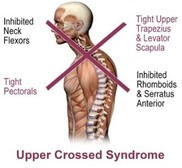 By: Julie Kulig, DC Do you know where your traps are? How about your upper trapezius? If you are shaking your head no right now- you are activating this muscle. It’s the muscle at the base of your neck and the top of your shoulders where we commonly here people say “that’s where I hold my stress.” This muscle is also commonly over-activated in those with upper crossed syndrome. Upper crossed syndrome is a muscle imbalance syndrome. It is most common in those who sit for the majority of the day. Think about it, how often do you sit at work each day? How often do you sit at home? We are creatures that are born to move. Chronic prolonged sitting leads to joint decentration. Which leads to upper crossed syndrome which leads to further joint decentration. Which came first? The chicken or the egg. It’s a perpetual cycle. Joint centration or a neutral joint position occurs when joint surface congruency and muscles that support the joint are at their optimal position throughout the range of motion and thus are able to produce varying forces according to the required skill. The centrated joint allows for optimal load transference of muscular forces across the joint and along the kinetic chain, with minimal mechanical stress on the passive structures such as ligaments, capsule, cartilage, and joint surfaces. Upper crossed syndrome is a muscle imbalance pattern located at the head and shoulder regions. It is most commonly found in individuals who work at a desk or sit for the majority of the day. Upper crossed syndrome leads to tightness in your upper trapezius and levator scapula, along with your suboccipital musculature at the base of your skull. It “crosses” with tightness in the pectoralis major and minor on your chest. It leads to weakness of your deep neck flexors that “crosses” with weakness in your middle and lower trapezius, rhomboids, and serratus anterior. So we are left with a jutted chin and what some people may call a “hump” in the upper back. It also leads to dysfunction and joint decentration at the following joints: atlanto-occipital joint, cervicothoracic junction, T4-T5 segment and the glenohumeral joint. In this postural presentation the plumb line of our head becomes forward of the plumb line in our necks. This puts an anterior load on the cervical intervertebral discs, putting them at risk for a disc injury such as a disc bulge and/or disc herniation, which may result in serious neurological consequences. This syndrome can also lead to headaches, temporal-mandibular joint dysfunction, shoulder problems, pain in the neck, and upper back, along with increased load on the passive structures in our spine which may have an impact on the degeneration of our joints at a more rapid pace. This is due to the decentrated joints that occur from this muscular imbalance syndrome. Because of these problems, it is important for the issue to be addressed. We take the time at our office to assess joint function, look for any muscular imbalances, and work to strengthen and stabilize weak muscles, along with stretching the appropriate muscle that may be short. We also encourage activity and becoming a more active individual. Be active. Move well. Live well. www.ButlerDC.Com Comments are closed.
|
Archives
February 2020
Categories |
HoursMWF: 9am - 6pm
T: 10am-5pm R: 9am-5pm |
Telephone814-355-0032
|
Email
|
